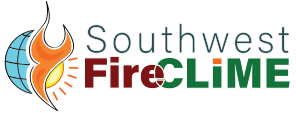
Resource Catalog
Document
The 'pyroclimatic hypothesis' proposed by F. Biondi and colleagues provides a basis for testable expectations about climatic and other controls of fire regimes. This hypothesis asserts an a priori relationship between the occurrence of widespread fire and values of a relevant climatic index. Such a hypothesis provides the basis for predicting spatial and temporal patterns of fire occurrence based on climatic control. Forests near the Mexico-United States border offer a place to test the relative influence of climatic and other controls in mountain ranges that are ecologically similar and subject to broadly similar top-down climatic influence, but with differing cultural influences. We tested the pyroclimatic hypothesis by comparing fire history information from the Mesa de las Guacamayas, a mountain range in northwestern Chihuahua, with previously published fire data from the Chiricahua Mountains, in southeastern Arizona, approximately 150 km away. We developed a priori hypothetical models of fire occurrence and compared their performance to empirical climate-based models. Fires were frequent at all Mesa de las Guacamayas study sites through the mid-20th century and continued uninterrupted to the present at one site, in contrast to nearly complete fire exclusion after 1892 at sites in the Chiricahua Mountains. The empirical regression models explained a higher proportion of the variability in fire regime associated with climate than did the a priori models. Actual climate-fire relationships diverged in each country after 1892. The a priori models predicted continuing fires at the same rate per century as prior to 1892; fires did in fact continue in Mexico, albeit with some alteration of fire regimes, but ceased in the United States, most likely due to changes in land use. The cross-border comparison confirms that a frequent-fire regime could cease without a climatic cause, supporting previous arguments that bottom-up factors such as livestock grazing can rapidly and drastically alter surface fire regimes. Understanding the historical patterns of climate controls on fire could inform the use of historical data as ecological reference conditions and for future sustainability.
Cataloging Information
- Arizona
- birds
- climatic controls
- diameter classes
- Durango pine
- elevation
- fire exclusion
- fire frequency
- fire management
- fire regime
- fire regimes
- fire scar
- fire scar analysis
- forest management
- land use
- Mexico
- mountains
- New Mexico
- Pinus durangensis
- Pinus durangensis
- Pinus ponderosa
- Pinus ponderosa var. arizonica
- Pinus strobiformis
- Pinus strobiformis
- ponderosa pine
- Rhynchopsitta pachyrhyncha
- sloping terrain
- snags
- southwestern white pine
- statistical analysis
- wildfires

This bibliographic record was either created or modified by Tall Timbers and is provided without charge to promote research and education in Fire Ecology. The E.V. Komarek Fire Ecology Database is the intellectual property of Tall Timbers.
